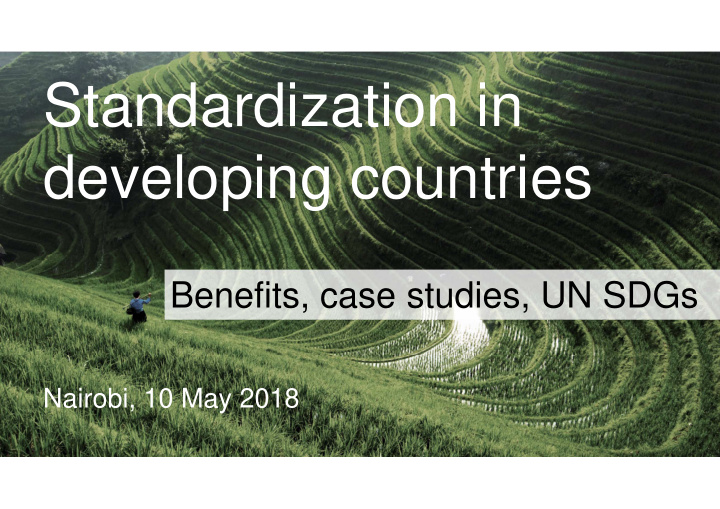



Standardization in developing countries Benefits, case studies, UN SDGs Nairobi, 10 May 2018
Benefits
Global relevance “…the characteristic of an ISO standard through which it can be used/implemented as broadly as possible by affected industries and other stakeholders in markets around the world”.
Benefits for developing countries • Standards are a source of up-to-date (and affordable) technical information • Possible basis for national regulations • Safeguarding national interests for imports • Access to export markets • Stimulation of competition
Benefits for consumers • Safer, healthier, more environmentally sound products and services • Compatibility within and between products • Greater consistency in the delivery of services • Better product or service information
Capacity building “…activities which strengthen the knowledge, abilities, skills and behaviour of individuals and improve institutional structures and processes such that the organization can efficiently meet its mission and goals in a sustainable way… ”
Why capacity building? • ISO’s most important resource is its member organizations and their networks of experts • Essential to strengthen the skills of our members, at the human and the organizational level, through extensive training and technical assistance programmes • Support members to maximize the benefits of international standardization and ensure the uptake of ISO standards • Effective participation of ISO members contributes to the global relevance of ISO standards and helps realize ISO’s vision of standards used everywhere
Activities • Technical assistance - specific programmes help our members to fully participate in global trade and achieve sustainable development, e.g. IT programmes, workshops, sponsorship • Training courses cover a wide range of subjects related to the standardization process and aim to help members participate effectively in standards development Courses target technical committee chairs, secretaries, working group convenors and their support staff
Core initiatives 1) National standardization strategies Helping members identify national standardization priorities and build national standardization strategies 2) Financial sustainability of national standards institutions Establishing strategies to ensure that their standards organizations are run efficiently and remain financially sustainable
Core initiatives 3) Stakeholder engagement Solid engagement strategies and collaboration schemes to ensure that the relevant stakeholders participate in the standardization work 4) Good standardization practice Evaluation of effectiveness of national standards institution, its standards development processes, and whether the standardization principles applied by the institution are in line with WTO Technical Barriers to Trade (TBT) Agreement
Case studies
Water Senegal (Sénégalaise des Eaux) Objectives : Streamline operations in drinking water services Standards used : ISO 9001, ISO 14001, OHSAS 18001 Results : • Established and met ambitious performance objectives and promoted a culture of continual improvement • Helped satisfy needs of Senegalese population for reliable water access • Improved efficiencies • Ensured positive occupational health and safety conditions for employees and suppliers
Shanghai Shuguang Hospital Objectives : Increase quality of medical services (reduce medical errors, ensure safety), decrease consumption of medical resources (operational effectiveness) Standards used : ISO 9001, ISO 15189 (medical laboratories), ISO 17025 (competence of testing and calibration laboratories) Results : • Quantification and improved procedures for various activities • Increased level of service, monitoring of quality • Increase in efficiency of use of information • Satisfaction of patients increased • Number of complaints reduced
More case studies: https://www.iso.org/benefits-of-standards-the-iso-materials.html
How do ISO standards contribute? ISO standards support the three pillars of sustainable development: • Economic – facilitating international trade, improving a country’s quality infrastructure • Examples: efficient farming, anti-bribery management systems • Social – improving health and well-being of citizens • Examples: healthcare systems, accessibility • Environmental – helping businesses/countries manage environmental impact • Examples: environmental and energy management systems
How are we contributing to meeting the UN SDGs? • Provide a website showing which standards correspond to each of the 17 SDGs • Includes links to the catalogue entry where additional details about the standard can be found • https://www.iso.org/publication/PUB100429.html
Thank you. mathew@iso.org
Recommend
More recommend